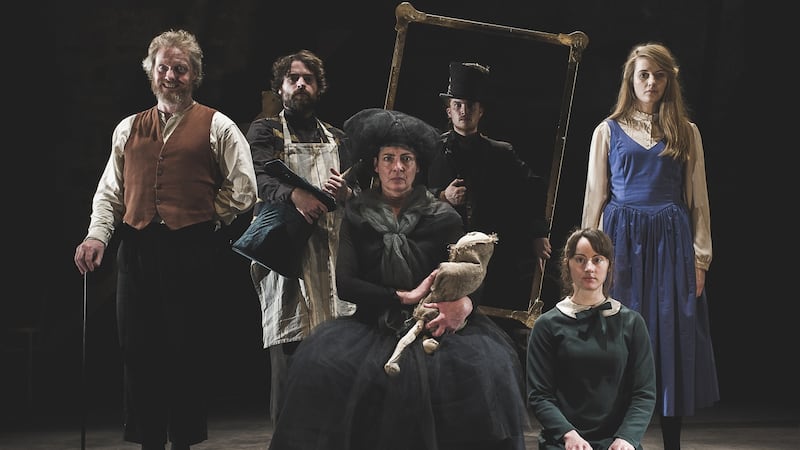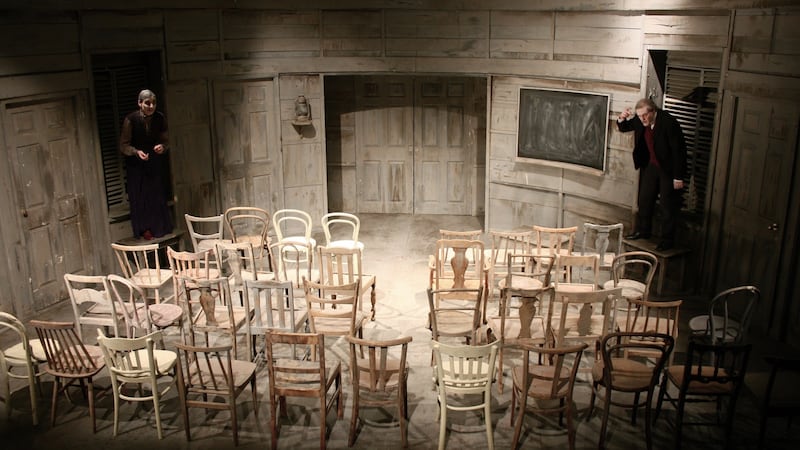Niall Henry is, as we chat, nearing the end of rehearsals for Happy Days, a process the artistic director of Blue Raincoat Theatre Company in Sligo is juggling with fluctuating Covid levels.
The plan is to perform Samuel Beckett’s two-act play, with Sandra O’Malley and John Carty, not in Raincoat’s usual intimate Factory performance space in Sligo, but for Covid distancing reasons, in part of the former Saehan factory in the 18th-century Hazelwood Demesne, just outside town. (Elsewhere in the vast building is a whiskey distillery, which seems somehow apt for the times.)
It’s the second time Blue Raincoat has produced Beckett in the industrial space, and Henry says “the location really resonates with his work”. Happy Days is very relevant at this moment: “Winnie’s loneliness and longing for her husband Willie’s companionship, while her body is buried at various stages in a mound, is absurd yet so simple. We all as humans want the assurance that someone is seeing and hearing us.”
As things pan out, the next day the whole country moves to Level 3, and even hyper-distant theatre indoors is out of bounds for now. Henry had been sanguine about the possibility of postponement; they’ll pack the production away and reschedule.
His calm in the face of the unknown may be borne of exactly 30 years of Blue Raincoat, Ireland’s longest running theatre ensemble which he founded with Carty, writer Malcolm Hamilton, Joe Hunt and Fionnuala Gallagher, most of whom are still involved (O’Malley joined a couple of years later).

It was simple enough at the beginning really. Let's do well-known, classic plays, and if they're crap it's our fault, it's not the play's fault
Back in 1990 Niall Henry came home from France, where he’d trained with Marcel Marceau and Camille Soun and was “living happily on cheese” in a flat beside Canal St Martin. Right now “I’m walking by the Garavogue and it’s raining on me, but anyways!” As a performer in his mid-20s in Paris, doing “crap work, but well-paid crap work”, he was open to starting a theatre company in his hometown: “We were obviously slightly not well in the head in the first place, because of heading off to drama school and that! Malcolm Hamilton wanted to be a writer and I wanted to be a director.”
He’s amusingly self-deprecating about the early years. “It was simple enough at the beginning really. Let’s do well-known, classic plays, and if they’re crap it’s our fault, it’s not the play’s fault. Because neither of us knew how to do a play.” A year in they had a base. “Then Malcolm made a couple of things that I made a mess of”, though he acknowledges they did good theatre too in those early years.
He mentions Hamlet, Macbeth, Midsummer Night’s Dream, Tom Murphy plays: “with some of them we tried to do something extra with visual or physical theatre. By accident we’d sometimes get things right, never by design, and sometimes we’d get things wrong. Like, trying to dance around the stage and say ‘To be or not to Be’ at the same time – so you didn’t know what to look at or listen to it, there was too much going on.”
A turning point came with Jocelyn Clarke’s adaptation of Alice in Wonderland, and “for the first time I felt: that’s us now, that suits us. There was a sort of balance in the type of theatre we were doing. And we followed that thread for the last 20 years.”
He talks expressively about early attempts to forge their theatre style, which ranges from the absurd worlds of Lewis Carroll and Flann O’Brien to more expressionistic devised shows like Shackleton and The School Days of Thaddeus K.
He was attracted to “physical and movement theatre, as opposed to pantomime. I always was very taken by Pina Bausch, or beautiful visual theatre but also” – he mentions loving Tom McIntyre’s The Great Hunger in the Peacock and Druid’s Wood of the Whispering – “by the drama. Somewhere in my 20-something year old mind, this sounds terribly naive now, but you were trying to create a synthesis. Years later I know that’s not the way to do it but I was trying to do something visual and dramatic at the same time.

“The universe of Lewis Carroll provided a very imagined world, which allowed us to play physically and visually. And if I call it a poor text, I don’t mean that it’s an unimaginative text, but it’s not a rich text like Shakespeare. But the ideas are rich. So, we fell upon the obvious, that you can’t do everything at the same time if you want to start playing with form. So the next 20 years really were tracking that discovery – to use that as sort of a template and move on.”
It was physical and visual, but also dramatic. “The story was important. You’ve got a balance. Certain types of stories began to suit us. That, you could nearly say existentential, world that we’ve done a huge amount of our plays in, seems to suit the type of theatre we’ve always wanted to do.”
He mentions a few productions that fit the shape he’s put on it. Flann O’Brien’s The Third Policeman “definitely suited us”. A friend doing a doctorate “was always banging on about it and I never took any interest until we did the play”, in 2006 and 2010. Ionescu’s absurdist classic The Chairs (2005 and 2012) is “my favourite play. I just love, love, love.”

First Cosmonaut (2013) by Jocelyn Clarke had Yuri Gargarin as a starting point for exploring the Overview Effect, with the first human seeing the earth from outer space, as a tiny, fragile blue ball of life.
Then there’s Shackleton (2016, nominated for The Irish Times Theatre Awards, Best New Play, Set and Sound design). “What attracted me in the Shackleton story was nothing to do with the Shackleton story. I have no interest in these derring-do men. But your man [Frank] Hurley’s photographs. He’s why we know so much about Shackleton. You have this extraordinarily beautiful wasteland, no life on it, and pictures of humans standing in it. The metaphorical clout there was huge.”
The attraction was “not to celebrate how good the man was but to try to touch the space of people in an empty landscape that is very beautiful and majestic. But, on the other hand, it’s a dead landscape.”
In much of this work, Niall Henry and Blue Raincoat worked with dramaturg and writer Jocelyn Clarke, whom he first met when he reviewed “a really bad version of At the Hawk’s Well” (“Poor auld Yeats. He did a handful of really interesting things. And after that, he just wasn’t a playwright. But we did even a bad version of one of his better ones.”)
Clarke “was kind, he didn’t tell the truth! And we hit it off. He’s been a huge collaborator, in the French Resistance sense of the word, for many years. He’s a brilliant man to work with.” They’d work through the week, then “he would come and have a look, and throw his eyes up to heaven, or not. That would give someone like me a deadline. And then we would discuss it, because I’m a bad talker. Contrary to this conversation, I prefer to be doing things in rehearsal.”
There's an element of the pandemic...that's exciting. Not exciting in terms of health, people and economies. But in terms of art – either the arts world is going to have to radically adapt, or not. And in many ways that's what we're supposed to be good at
Over three decades, too, Blue Raincoat has been involved in founding an arts festival, a youth theatre, a children’s theatre festival, and a theatre academy of short courses with international experts for Irish professionals. As part of Sligo’s cultural ecosystem Henry is also involved in Tread Softly landscape festival; two projects this year – sand art sculptures and his partner Bettina Seitz’s underwater sculpture exhibition – offer inspiration for Covid-proofing creative work.
“There’s an element of the pandemic, and I’m going to be hung for this, that’s exciting. Not exciting in terms of health, people and economies. But in terms of art – either the arts world is going to have to radically adapt, or not. And in many ways that’s what we’re supposed to be good at. Time will tell. I was really looking forward to seeing Sandra, whom I’ve worked with for 28 years, do Winnie this week but we will do Winnie over the next six months. The challenge is, if we’re in lockdown for months, what sort of art can we do?”
He’s tumbling over with ideas and community projects, like an installation about “Scott’s right-hand man Wilson who went away in the middle of the winter to get three Emperor penguin eggs”, or another marking next year’s 1,500th anniversary of the Battle of the Books.
“This is a Covid-proof idea – unless they find a Level 6!” he roars laughing. “We curate a book representing 1,500 years of history, a symbol of our time here in the northwest, we get our first citizen to present that to a child refugee from another country. Then we as a community give copies of that book to Sligo’s 24,500 households. It’s like a ritual.”
When the first lockdown happened Blue Raincoat had just started a development workshop around James Lovelock, who formulated the Gaia hypothesis (about living organisms creating a synergy with inorganic), working on a hook for what would be “an absurd piece of theatre, not a deadly serious piece”; we have, he observes, “very absurd people running very powerful countries”. Then all of a sudden this Covid thing started and the airplanes are taken out of the sky, so in a very comic Monty Python/serendipitous sense, we were in the middle of the James Lovelock theory. It was too weird for words.”












